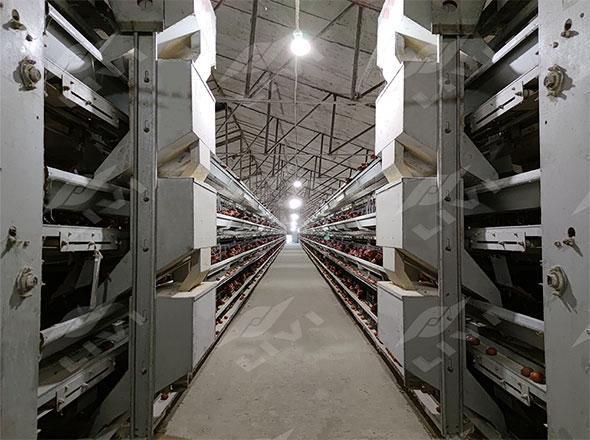The global demand for poultry products continues to rise, and commercial farmers are turning to modern technology to increase efficiency, maximize output, and ensure consistent quality. One of the most effective ways to achieve these goals is by investing in commercial poultry equipment — specifically, a large-scale 20,000 battery chicken cage project.
This article explores what such a project entails, the equipment involved, cost considerations, and the long-term benefits it offers to poultry farmers.

What is Battery Chicken Cage System?
A battery chicken cage system is a structured, multi-tier housing system designed to keep chickens in organized rows and columns. This design maximizes the use of space, ensures easy management, and integrates with automation systems.
Unlike deep litter or free-range setups, battery cages are designed for high-density poultry farming, making them ideal for projects with 20,000 birds or more.
Types of Battery Cages
-
A-Type Cages – Suitable for smaller farms, usually 2–3 tiers.
-
H-Type Cages – Preferred for large farms; can be stacked up to 6–8 tiers and integrate well with automation.
For a 20,000 bird project, H-type cages are typically the best choice due to their high stocking density and efficiency.
Key Commercial Poultry Equipment for 20,000 Bird Project
Setting up a large-scale poultry farm requires more than just cages. A complete commercial system integrates multiple components to reduce labor and increase production.
1. Chicken Battery Cages
-
Hot-dip galvanized steel for durability (lifespan 15–20 years).
-
Designed with smooth surfaces to prevent bird injuries.
-
Multi-tier structure to house 20,000 layers in a compact space.
2. Automated Feeding System
-
Feed is distributed through conveyor belts or augers.
-
Ensures every bird gets equal access to feed.
-
Reduces labor costs and prevents feed waste.
3. Automatic Drinking System
-
Nipple drinkers installed at each cage level.
-
Provides clean, fresh water with zero spillage.
-
Lowers risk of contamination and disease spread.
4. Egg Collection System
-
Conveyor belts carry eggs from cages to a central collection point.
-
Reduces egg breakage and ensures quick handling.
-
Improves efficiency in large flocks.
5. Manure Removal System
-
Manure belts beneath each tier remove waste automatically.
-
Reduces ammonia buildup and odor.
-
Improves bird health and lowers disease risk.
6. Ventilation and Climate Control
-
Fans, cooling pads, and heaters regulate house temperature.
-
Ensures optimal conditions for high egg production.

Project Capacity: 20,000 Layers
A 20,000-bird commercial poultry project is designed to house layers for egg production. Here’s what it typically looks like:
-
Cage Configuration: 4–6 tiers of H-type cages.
-
Stocking Density: About 8–10 hens per cage unit.
-
Housing Area Required: Roughly 1,200–1,500 square meters depending on cage design.
-
Expected Egg Output: If layers average 85–90% production, the farm can produce 17,000–18,000 eggs per day.
This output ensures high profitability and quick return on investment when managed efficiently.
Cost Considerations for 20,000 Bird Battery Cage Project
Prices vary depending on supplier, automation level, and local installation costs. Below is a breakdown:
-
Battery Cages (H-Type, 4–6 tiers): $20,000 – $30,000
-
Automated Feeding System: $4,000 – $8,000
-
Automatic Drinking System: $2,000 – $4,000
-
Egg Collection System: $5,000 – $10,000
-
Manure Removal System: $3,000 – $6,000
-
Ventilation & Climate Control: $8,000 – $10,000
-
Other Costs (building, installation, shipping): $10,000 – $20,000
Estimated Total Investment: $32,000 – $78,000
While this may seem high, most farmers recover their investment within 1–3 years due to high egg production and reduced labor costs.
Benefits of a 20,000 Battery Cage Project
-
High Efficiency
Automation allows one worker to manage thousands of birds. -
Better Bird Welfare
Clean environment with constant access to feed and water reduces stress. -
Improved Hygiene
Automatic manure belts remove waste, lowering disease risk. -
Consistent Egg Production
Birds lay more eggs when housed in clean, stress-free conditions. -
Space Optimization
Multi-tier cages maximize limited land space. -
Sustainability
Manure can be collected and processed into organic fertilizer.

ROI and Profit Potential
Assuming 20,000 layers with an 95% laying rate:
-
Daily eggs = ~19,000
-
Monthly eggs = ~570,000
-
If sold at $0.08 per egg → $45,600/month revenue
-
Subtract feed, labor, and operational costs (~$20,000/month)
-
Net profit = ~$20,000/month
This means farmers could recover their initial investment in as little as 5–8 months in favorable markets.
FAQ: Commercial Poultry Equipment 20,000 Battery Cage Project
Q1: How many cages are needed for 20,000 birds?
Typically, 4–6 tier H-type cages with around 100–140 units will house 20,000 layers.
Q2: What is the cost per bird in such a project?
Costs usually range from $2–$5 per bird, depending on automation and cage material.
Q3: Can battery cage systems be customized?
Yes, manufacturers can design cage layouts to match farm size, bird type, and automation needs.
Q4: How long do battery cages last?
Hot-dip galvanized systems last 15–20 years with proper maintenance.
Q5: Are battery cages suitable for both layers and broilers?
Yes, but designs differ. Layers need sloped floors for egg collection, while broiler cages are built for faster growth.
Conclusion
A 20,000 battery chicken cage project equipped with commercial poultry equipment is a game-changer for farmers looking to scale operations. While the initial investment may reach $32,000 – $78,000, the long-term benefits — high efficiency, better hygiene, and strong profitability — make it a smart and sustainable choice.
By adopting modern automation in feeding, drinking, waste management, and egg collection, poultry farmers can maximize output while minimizing costs, securing a competitive edge in today’s fast-growing poultry industry.
